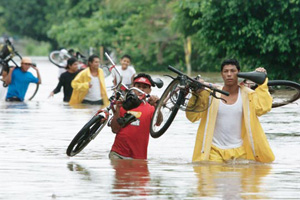– Hurricane Gilbert: this is one of the most devastating hurricanes to affect the northern Atlantic coast. It was formed on September 18th of 1988 in the warm waters of the Caribbean, and touched solid ground for the first time in Jamaica, converting into a category 4 hurricane on the Saffir-Simpson scale (winds close to 240 km/h). As it distanced itself from the Central American country, its intensity increased, reaching category 5. With all of this force, it hit the Cayman Islands.
– Hurricane Mitch: this is categorized as one of the most violent hurricanes in the last century. It was formed on October 22nd of 1998, south of Jamaica, and it reached the highest category on the Saffir-Simpson scale, with winds that reached almost 300 kilometers per hour. It devastated extensive zones of various Central American countries (mainly Honduras, Nicaragua, Guatemala and El Salvador) and caused severe flooding, landslides and mudslides, among other damage.
It was among the most deadly hurricanes, as 10,000 dead were counted after its passage. Hurricane Mitch devastated enormous agricultural regions; in Honduras alone, it left all coffee production zones unusable and destroyed the warehouses of the main exporting companies of this country.
– Hurricane Katrina: it struck the southern and central United States in August of 2005. Despite being found only in sixth place on the list of the most violent hurricanes on record, it is considered one of the most deadly and costly hurricanes in North America (almost 75 billion dollars was the total cost of repairs). In addition, it made history as the greatest natural disaster in decades. It continued along its path until the Gulf of Mexico, growing in size and energy until becoming a category 5. On August 29, it arrived in the states of Louisiana and Mississippi, with 250 km/h winds, whose forced tore down thousands of houses and buildings, petroleum industry structures, highways and bridges, leaving a large part of the country’s population without communication or supplies. It caused enormous material damage and thousands of deaths.
– Cyclone Bhola: this is among the greatest disasters of this kind worldwide. In 1970, strong winds destroyed important cities in Bangladesh and left more than five hundred people dead. It was named after one of the many islands it struck, many of which were left in absolute misery.
– Cyclone Tracy: it tore down the city of Darwin (Australia) on Christmas of 1974. It is characterized by its slow advance and great destructive power. Since it entered into contact with solid ground it didn’t surpass 8 km/h, while its winds easily surpassed 200 km/h. For more than five hours it tore down almost all of the city’s buildings; more than 60 dead were counted, among them inhabitants of the city and fishermen who were guarding their boats.
Although it began as a weak tropical storm more than 724 kilometers from the Australian city, it transformed into a violent phenomenon. It was classified as a cyclone near December 21st, a date categorized at the beginning of hurricane season in the South Pacific.
– Cyclone Sidr: last November 15th, this cyclone destroyed a large part of southern Bangladesh and a part of eastern India. More then 500 kilometers in diameter, with winds that reached 240 km/h, it was characterized by its violence and the quantity of fatal victims (close to 2,800). Many lost their lives due to the collapse of their precarious shelters, constructed with flimsy materials such as bamboo.
Another factor was added to this tragedy; cyclone Sidr destroyed more than 25% of one of the most important ecological zones worldwide: the Sunderbans delta. This region shelters some of the oldest mangroves in the world, and in addition, it is a habitat for endangered species, such as the Bengal tiger (Panthera tigris tigris) and the Ganges River dolphin (Platanista gangetica).








 Muere Evita
Muere Evita